RPG Review: Dungeon Hack (1993, SSI, Inc)
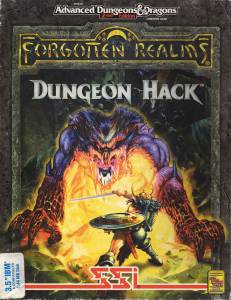
You'd have been hard-pressed to find a company flying much higher in the early 90's than TSR. Between the recently-published 2nd edition of Advanced Dungeons & Dragons (aka: the best-selling pen-and-paper RPG in history) and a slew of hit computer games produced by SSI which used the AD&D License, TSR's market position was so perfect it could have appeared in an updated version of the Kama Sutra. Never mind the crapfest that went down a few years later--at this point TSR looked and felt immortal. They could do no wrong. Fortunately, unlike some other D&D games I could mention, SSI's 1993 release of Dungeon Hack based on the AD&D and Forgotten Realms licenses did nothing to tarnish that reputation.
Note: This piece first appeared in print at Retro Gaming Magazine in 2015. I appears here in a slightly revised format. Curious readers can access the original here.

Title Screen
Dungeon Hack takes virtually all of its cues from Rogue, an early adventure title developed for the Unix-based PDP systems found on many college campuses in the early 80s. While other players were stumbling through Colossal Cave Adventure and learning how to interact with the text-based parser, the developers of Rogue noticed a major problem with that maze of twisty little passages, all alike: once you figured out the solutions to the puzzles, there wasn't much left to do. Starting a new adventure put you right back in the same place you started the last one, the treasures were exactly where you found them the last time, and riddle answers never changed. While there were some random elements, like the dwarfs patrolling the maze who occasionally heave an ax at your face, 90% of the challenge evaporated once you'd beaten the game.
Rogue went in its own direction. Every game featured a new dungeon built by procedural generation--while you might find another +2 spear while playing your second game, you wouldn't find it carried by the same Orc you slew the last time. That Orc could be a kobold, a green slime, a skeleton, a pit trap, or not even there at all. This effect extended not just to monsters and rooms, but magical items as well: a yellow potion in one game might heal you, while the same yellow potion in the next game would make you levitate for a short period of time. The scroll which produced a fireball last game might summon a monster to attack you if read this time around. Finally, when you died, that was it. The adventure was over, and you had to begin a new quest at level 1 all over again. If this all sounds somehow familiar, it means you've played some incarnation of Diablo in the last twenty years.
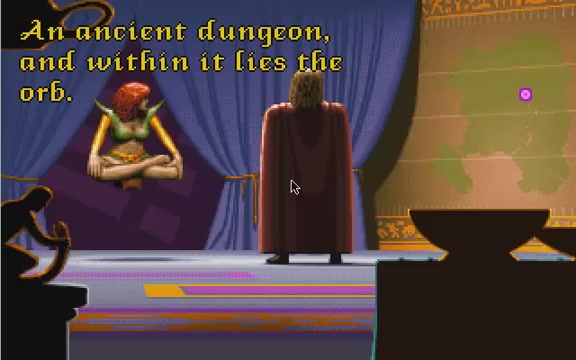
Can't you find a closer artifact for me to chase, lady?
Dungeon Hack set out to not only emulate, but also surpass, the success of Rogue by offering many of the same elements built on the scaffolding of the rule-set for 2nd Edition AD&D. Set in the Forgotten Realms, the largest and most popular campaign setting in Dungeons & Dragons history, and populated with an assortment of traps, treasure and monsters yanked straight from the hardcover rule books every nerd worth his or her gaming credit kept on the bookshelf, Dungeon Hack had mountains of source material upon which to build its labyrinths of terror. But where Rogue used simple ASCII characters to represent the dungeon, its treasures and inhabitants, relying on player imagination to fill in the gaps, Dungeon Hack took the computing power available in 1993 and set it up to display everything in full color, 2D bit-mapped, sprite-animated, first-person perspective, real-time glory.
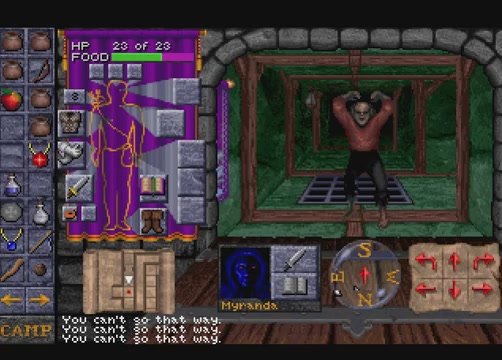
Zombies in the sewers!
Then it went a step further. While literally everything about Rogue was determined at random, Dungeon Hack allowed players to tailor their experience with the game to make it larger, smaller, easier or more difficult based on their personal tastes. While Dungeon Hack won't go so far as to let players hand-build their own dungeon, it offers enough options to let even the hardest of the hardcore D&D elite find a play style to appease them. Everything from the number of floors in the dungeon and the frequency of traps to how quickly your adventurer consumes food and whether or not undead show up can be altered, added or removed. Each movement of a slider changes the dungeon's seed, a 19-character assortment of letters and numbers which can be shared with others to let them experience your own dungeon and see if they can fare any better (or worse) than you did.
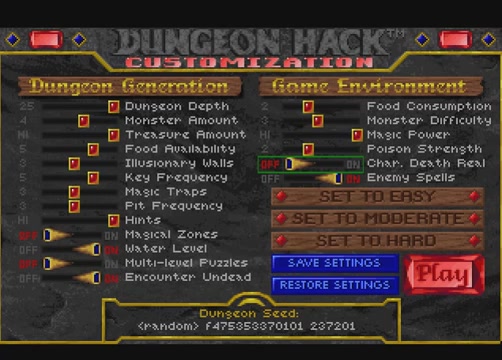
"Customize THIS!"
All that doesn't even touch character creation, where almost any class/race combination including Rangers and Paladins as well as multi-classed characters like Fighter/Cleric or Thief/Mage permitted under the rules in the 2nd edition Player's Handbook are viable choices. Yes, you can even play a Bard if you think your skills with a lute will help you in any way, shape, or form.
 )
)Bards: ruining dungeon crawls with incessant noise since 1981.
While your stats are rolled at random, you are free to modify them up or down as you see fit--a necessary precaution to ensure you can truly play any class you like, since many have required minimums in one or more stats. You can also use it to cheat like the dickens and make your character a virtual demigod. Not that any of you reading this would ever--
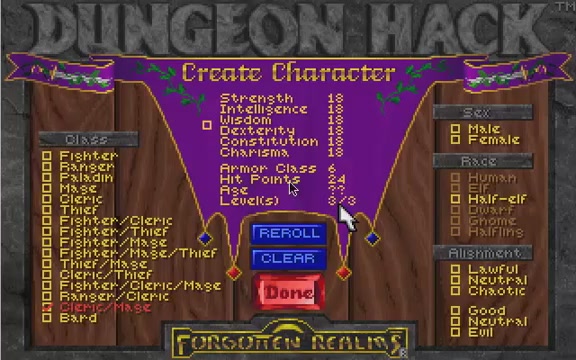 )
)Damn it, @triverse!
So then: you've, ahem, "rolled up" your character, set the specifics for the dungeon however you liked, and are ready to play! May the odds be ever in your favor, because Dungeon Hack laces up its Boots of Groin Kicking +5 as soon as the drawbridge closes behind you. Anyone who's played D&D before knows the ideal game consists of one Dungeon Master serving as referee, and anywhere from 4-6 players crowding the table playing a variety of classes and races to make sure they're ready for as many eventualities as possible. While the computer serves as a semi-competent DM in that it lets you get away with virtually anything prior to entering the dungeon, but holds you and itself firmly to the rules once that door slams shut, Dungeon Hack is a one-player-only experience. You're always going to lack in some regard, even if you multi-class. Fighter/Mage characters will always hurt for healing spells, and Cleric/Mage sorts will have difficulty dealing with traps they come across. If you want to have any hope of survival, dual-classing as a something/Cleric is almost mandatory. If you want to experience the gaming equivalent of a prolonged and humiliating public castration, waltz into the spider's web as a generic Thief and watch how quickly your hit point gauge runs into the negatives.
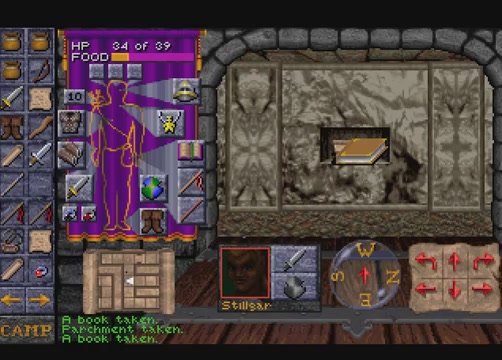
Ah, treasure!
"Why are we going into the dungeon in the first place, Michael?"
So glad you asked, @retro-room. The answer is, "Because it's there."
What, you want more than that? Okay, okay, there's some to-do with a floating sorceress who's looking for a special orb currently moldering away in the depths of this misbegotten labyrinth, and she's offering a reward (plus whatever else you manage to loot) to anyone who can bring it back.
Negotiations for a cash advance, which seems only fair since I could use some fresh equipment and a visit to the local brothel for possibly my last roll in the hay, are met with contempt and end with me teleported to the dungeon's front door.
Sigh.
Well, here's to hoping someone died near the entrance with armor in my size and a good sharp blade.
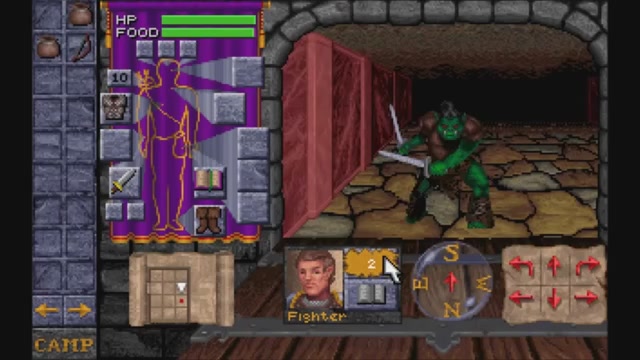
Well, this sucks...
Dungeon Hack's graphics won't blow your mind, but they are very good for a DOS game of the time. The dungeon levels pull their artwork from a variety of tile sets, offering everything from dimly-lit caves with rough-hewn walls and puddles everywhere to immaculately-finished and polished corridors with beautiful tapestries adorning the walls. These change between levels, so don't be surprised to go from a place that looks like an abandoned sewer complete with rusted floor gratings on one level to a red-walled temple to some long-forgotten deity on the next, and an ancient burial crypt after that. Dungeon Hack's best feature in my opinion is the built-in auto-mapper which prevents would-be explorers going through reams of graph paper, and conveniently marks the locations of locked doors, traps, illusory walls (at least once you've blundered through them), staircases, monsters and dropped objects.

Suck it, Phantasy Star.
This game is ridiculously challenging even for veteran RPG buffs and AD&D enthusiasts alike. That challenge and replayability is ultimately what will keep you coming back to Dungeon Hack. Build your character, cross your fingers, then pray for good drops and plenty of food (or a Ring of Sustenance at the very least). Also think about what you want carved on your tombstone, because for most players, a witty epitaph is the best outcome you can hope for. I've been playing off and on for over a decade, and I've yet to come anywhere close to finding the orb. Once the Death Knights show up, you either have access to fire resistance or you get intimately acquainted with the smell of your own charred flesh. Don't even get me starting on Living Mucks. You'll learn about them soon enough.
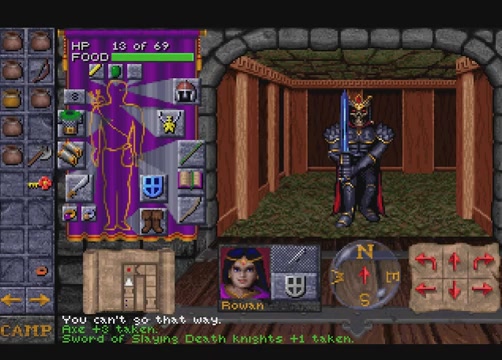
When a game offers you a Sword of Slaying Death Knights, you know shit just got real.
If you want to experience Dungeon Hack for yourself (and let's face it, you've read this far so you're at least intrigued by the idea), the best way to do so is to hitchhike over to GOG.com and pick up Forgotten Realms: The Archives - Collection 3 which contains both this game and its spiritual sequel Menzoberranzan, which is a more straightforward, party-based adventure. It'll set you back six US dollars (less if you wait for a sale), but it's worth it not to mess with a stack of 3.5" floppies, emulators, and finding a copy on eBay. Now, enjoy your retro ad goodie:
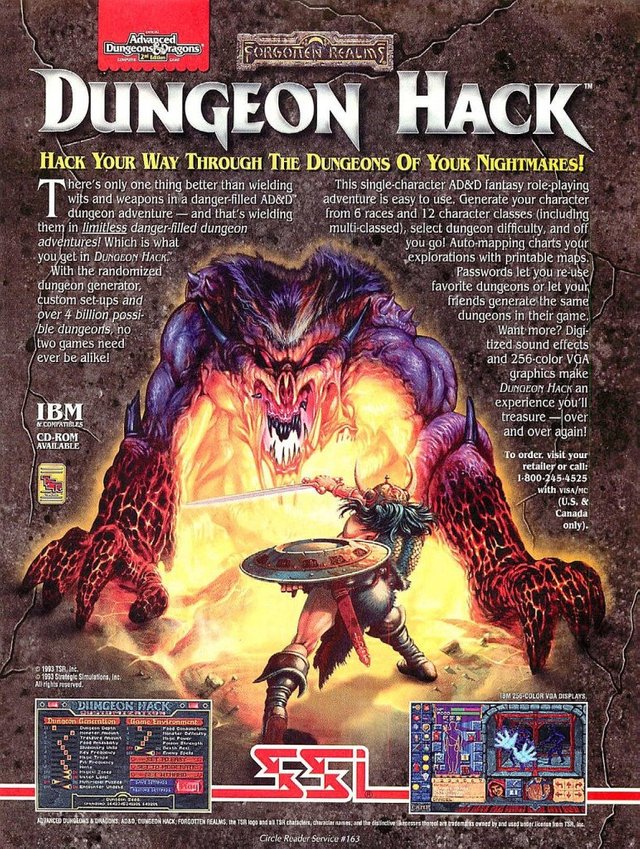
Emazing story @modernzorker